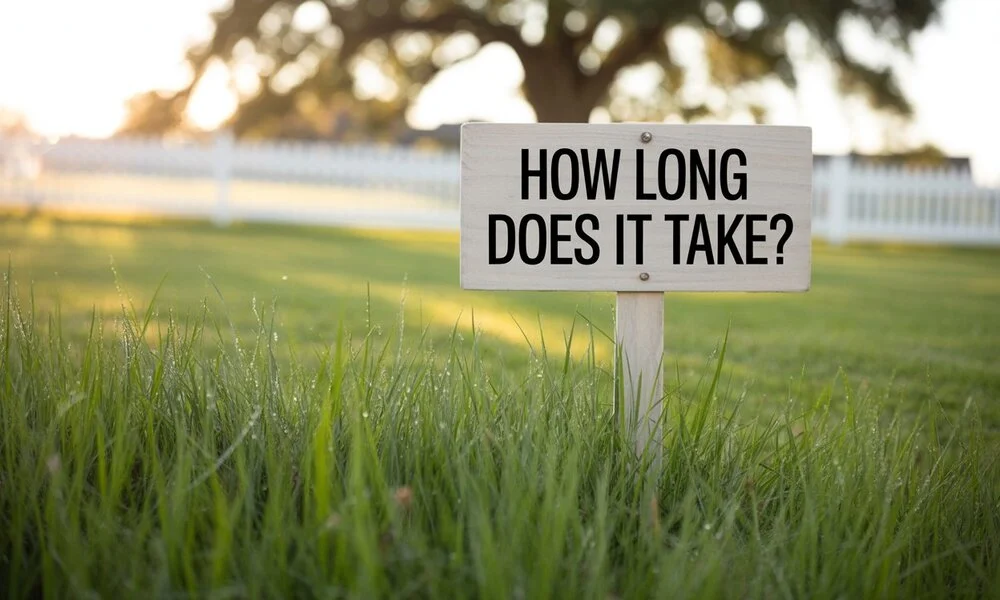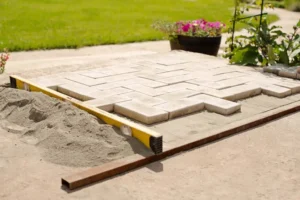How long does a lawn take to grow depends on several factors, but understanding the general timeline is essential for setting realistic expectations. Whether you’re a homeowner aiming for a lush green yard, a landscaper planning a new installation, or a turf manager maintaining large areas, timing plays a critical role in achieving healthy, full coverage. Growing grass from seed takes patience, as germination and establishment vary by grass type, soil conditions, and climate. When asking, “growing grass from seed how long?”, the answer usually ranges from 7 to 30 days for germination and several weeks to months for a mature, mow-ready lawn. Proper planning, care, and consistency are key to successful lawn establishment.
Factors That Affect Lawn Growth

Lawn growth isn’t just about planting seeds and waiting—it’s a balance of several critical factors that influence how quickly and successfully your grass establishes. From soil health to seed type, each element directly affects grass seed germination time and overall grass seed growth. Here’s a breakdown of what matters most:
1. Grass Type (Cool-Season vs. Warm-Season Grasses)
Different grass types have unique growth timelines. Cool-season grasses like Kentucky bluegrass or fescue typically germinate and grow best in spring and fall, while warm-season grasses such as Bermuda or Zoysia thrive in the summer. Choosing the right type for your climate will ensure faster grass seed germination time and healthier turf development.
2. Soil Quality and pH Levels
Healthy soil is the foundation of successful grass seed growth. If your soil is compacted, lacks nutrients, or has an imbalanced pH, it can delay germination and hinder root development. Conducting a soil test and amending the ground with compost or lime (as needed) can improve conditions and shorten the grass seed germination time.
3. Climate and Regional Conditions
Temperature and humidity levels play a major role in how fast your lawn grows. Seeds need consistent warmth for proper germination. If conditions are too cold or too hot for your chosen grass species, you might experience patchy or delayed grass seed growth.
4. Watering Frequency and Consistency
Moisture is essential for seed germination. Inconsistent watering can dry out the seedbed, extending the grass seed germination time or leading to failed growth. Aim for light, frequent watering—especially in the first two weeks—to keep the topsoil moist but not soggy.
5. Sunlight Exposure
Most grass varieties need 4–6 hours of direct sunlight daily. Lawns in shaded areas may experience slower or uneven grass seed growth, and you might need to choose a shade-tolerant grass seed to ensure better performance.
6. Fertilization and Nutrients
Applying a starter fertilizer during seeding provides essential nutrients that accelerate root development and shoot growth. Lack of nutrients can prolong the grass seed germination time and lead to weak turf. Choose a nitrogen-rich fertilizer designed for new lawns.
7. Lawn Preparation and Seedbed Quality
Proper site preparation is often overlooked but crucial. Loosening the top few inches of soil and removing debris ensures good seed-to-soil contact, which significantly improves grass seed germination time and long-term lawn health.
You may read about How Much Lawn Care Cost?
How Much Time Does It Take For A Lawn To Grow?
How long does it really take to grow grass from seed? The answer depends on your method, maintenance, and environmental conditions. On average, lawn establishment involves several phases—from seed germination to full turf coverage—and understanding this timeline helps set realistic expectations.
General Timeline: From Seed Germination to Full Coverage
When growing grass from seed, how long it takes to see results starts with grass seed germination. Most grass varieties begin germinating within 7 to 30 days under ideal conditions. However, germination is just the beginning of grass seed growth. It typically takes 6 to 10 weeks for a seeded lawn to reach full, mow-ready density.
Timeline Comparison: Seed vs. Sod vs. Hydroseeding
- Grass Seed: Slowest method; visible germination in 1–4 weeks; full coverage by week 6–10. Requires regular watering and care for successful grass seed growth.
- Sod: Instant green appearance with full root establishment in 2–3 weeks. Best for fast results but more expensive.
- Hydroseeding: Mid-range option; germinates in 5–10 days; full growth in 4–8 weeks. Often used for larger areas with better erosion control.
Typical Growth Time Range
Most lawns seeded with cool- or warm-season grasses fall within these timelines:
- Germination: 7–30 days
- Initial lawn coverage: 3–5 weeks
- Full lawn establishment: 6–10 weeks
Factors like soil temperature, watering, and sunlight can either speed up or delay grass seed growth.
Maintenance Tips During the Initial Weeks
To ensure successful grass seed growth, follow these early-care tips:
- Water lightly and frequently to keep the seedbed consistently moist.
- Avoid heavy foot traffic during the first 4–6 weeks.
- Apply a starter fertilizer within the first week of seeding.
- Mow only when grass reaches 3–4 inches, and never cut more than one-third of the blade.
By understanding the timeline and providing the right care, growing grass from seed—how long it takes and how well it fills in—can be a manageable and rewarding process. For Commercial Lawn Care service in the Bay Area contact Lakota Design Group.
How Long Does a Lawn Take to Grow from Seed

The length of time needed to grow grass from seed varies depending on the species of grass, the state of the soil, and the maintenance schedule. Understanding the specific stages from seeding to a fully established lawn helps you plan and manage expectations. Here’s what you need to know.
Seed Germination Times by Grass Species
Different grass types germinate at different rates. Here’s a quick overview of grass seed germination times for popular varieties:
- Kentucky Bluegrass: 14–30 days
- Tall Fescue: 7–12 days
- Perennial Ryegrass: 5–10 days
- Bermuda Grass: 7–14 days (warm soil required)
- Zoysia Grass: 14–21 days
If you’re asking, “growing grass from seed, how long until I see green shoots?”—the answer heavily depends on the grass type and growing conditions.
Timeline for Visible Growth and Mowing Readiness
After germination, most grasses continue growing rapidly:
- Week 1–3: Germination phase; tiny sprouts begin emerging.
- Week 3–5: Noticeable thickening and grass seed growth accelerates.
- Week 5–7: Lawn starts filling in; grass reaches mowing height (3–4 inches).
- Week 7–10: First mowing is usually safe. Lawn becomes visually complete but still developing roots.
Importance of Seed-to-Soil Contact and Moisture
A successful lawn starts with good seed-to-soil contact. This ensures the seed absorbs water and nutrients effectively. Without proper contact, even high-quality seed will fail to germinate.
Consistent moisture is equally critical—seeds must stay damp (but not soggy) throughout the germination phase. Dry conditions can delay or halt grass seed growth entirely.
Week-by-Week Lawn Growth Breakdown
Week 0:
- Prepare soil, remove debris, level ground
- Spread seed evenly and rake in for good soil contact
- Begin light, frequent watering (2–3 times per day)
Week 1–2:
- Seeds begin sprouting (Perennial Ryegrass, Fescue)
- Continue moistening soil to encourage uniform germination
Week 3–4:
- Sprouts emerge for slower species (Bluegrass, Zoysia)
- Growth becomes visible across most of the lawn
Week 5–6:
- Taller grass blades develop
- Lawn coverage becomes dense
- You can mow once the grass is 3–4 inches tall
Week 7–10:
- Regular mowing begins
- Deeper root development takes place
- Lawn starts to look fully established
Conclusion
Growing grass from seed—how long it takes—typically ranges from 7 to 30 days for germination and 6 to 10 weeks for full lawn establishment. Success depends on proper soil prep, moisture, and ongoing lawn care. By understanding the growth timeline and following best practices, you can achieve healthy and consistent grass seed growth. For faster, professional results, consider working with experts. Lakota Design Group offers tailored landscaping solutions to help you grow a lush, green lawn. If you need guidance or support, contact us today. Let’s bring your landscape vision to life.
FAQs
Q1: How Long Does It Take For Grass Seed To Germinate?
Most grass seed begins germinating within 5 to 30 days, depending on the variety. Perennial ryegrass germinates in as little as 5 days, while Kentucky bluegrass may take up to 3 weeks.
Q2: When Will I See Visible Grass Growth After Seeding?
You’ll typically start seeing visible grass seed growth within 7 to 14 days after germination starts. Full lawn coverage usually develops within 6 to 10 weeks.
Q3: What Factors Influence How Fast A Lawn Grows?
Grass seed germination time is affected by grass type, soil quality, watering, sunlight, and climate. Proper care can speed up the entire lawn growth process.
Q4: Is Sod Faster Than Growing Grass From Seed?
Yes. Sod provides an instant green lawn and establishes roots in 2 to 3 weeks, while growing grass from seed can take 6 to 10 weeks for full coverage.
Q5: How Do I Speed Up Lawn Growth After Seeding?
Ensure proper seed-to-soil contact, water consistently, apply a starter fertilizer, and avoid foot traffic in the first few weeks to promote strong grass seed growth.





